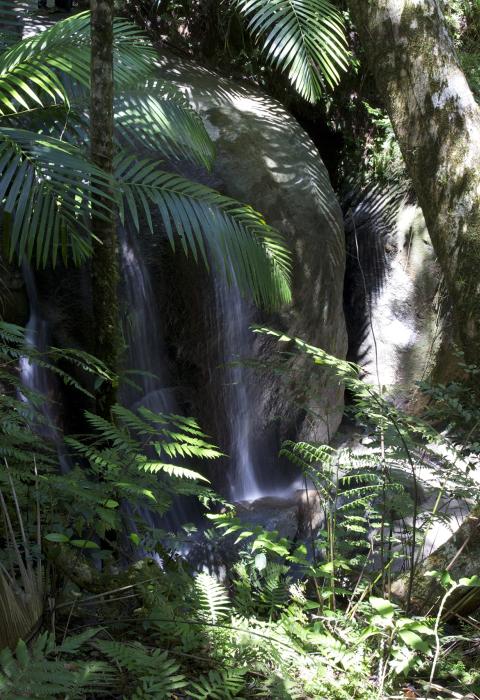Rio Icacos
Puerto Rico
The Rio Icacos originates in the upper elevations of the El Yunque National Forest at over 2,000 feet and flows south. The stream gradient is less steep near its headwaters elevation at 2,158 feet than farther downstream in contrast to all other rivers on the forest. The river exhibits a unique sandy bed due to its upper flatter sections. Contrasting sharply is the downstream segment, which more closely resembles other rivers in the forest with huge, jumbled boulders, rapids, and steep gradients. The lush and varied vegetation that is found along the banks provide a very picturesque setting.
Designated Reach
December 19, 2002. From its headwaters to the boundary of the Caribbean National Forest.
Outstandingly Remarkable Values
Botany
The tropical moist forests of Puerto Rico are characterized for their great diversity of plants, although somewhat less so than in continental tropical forest. More tree species occur on the El Yunque than in all the other 155 national forests combined, and none of these species occur on any other national forest. The Rio Icacos corridor within the forest contains five ecological life zones—subtropical wet forest, subtropical rain forest, lower montane wet forest, lower montane rain forest, and a small area of subtropical moist forest. Its vegetation includes four major forest types—Tabonuco, Palo Colorado, Sierra Palm, and Cloud Forest. Nearly one-third of the forest’s tree species are endemic to Puerto Rico, and 10% are endemic to the forest itself.
The core of the forest remains in primary condition without significant human modification. This primary forest is the largest remnant of the original forest that covered virtually the entire island at the time of Columbus’ arrival more than 500 years ago. The primary forest presents a unique window to the past and a natural control against which past, and ongoing changes, in Puerto Rico’s and other tropical forests, can be measured. It provides the only currently suitable habitat for many endemic plant species.
Culture
The Rio Icacos has pre-Columbian petroglyphs located downstream from the corridor and the potential for others within it. There is one rock shelter within the corridor, with Spanish Colonial ceramics in association with flaked stone tools.
Geology
Elevation on the forest ranges from 100 feet at the northern boundary to 3,533 feet at El Toro Peak. On the forest’s south slopes, the Rio Icacos is less steep near its headwaters than further downstream. Geologic parent materials are of three basic types: marine-deposited Cretaceous volcanic rocks are the most widespread; tertiary intrusive quartz diorites occur on the south side of the forest; and quaternary unconsolidated alluvial deposits (sand, gravels, silts, and clays) occur along major water courses.
History
The forest contains a variety of historical resources. The Rio Icacos corridor has Civilian Conservation Corps projects and sites dating from the 1930s, including trails, work camps, and PR Highway 191, as well as an earlier hydroelectric dam and penstock beyond the south end of the corridor.
Recreation
The major recreational experiences are passive enjoyment of the natural environment, picnicking, wading in the water, and hiking. Currents within the rivers are generally conducive to water play. The river is relatively shallow and has easy access between the rocks and along the banks. The large boulders make the stream a good place for sitting and cooling off. Recreation tends to be family activity oriented. Most of the river corridor is primitive with minimal human activity. Bird watching and nature photography are also very popular along the river corridors. Primitive camping is permitted, with proper permitting, along a closed segment of PR Highway 191 which runs parallel to the Rio Icacos.
Scenery
The Rio Icacos has a sandy base and shorelines along the upper segments of the river. In its lower segment, it becomes steep with huge rock outcrops. The riverbanks are lined with large native trees as well as tree ferns and palms.
Wildlife
The fauna that is found along the river corridor is one of the most distinguishable communities in Puerto Rico. Species exhibit traits unique only to tropical ecosystems. Aquatic, bird, and terrestrial animal species on the forest have many distinct characteristics that have evolved through interactions that promote specialization.
The El Yunque National Forest boasts a spectacular degree of biodiversity in comparison to other national forests. The range of species includes over 127 terrestrial vertebrates, 77 bird species, and 17 freshwater fish species. Wildlife can be observed and photographed in the treetops, along the shoreline, and in the water of the Rio Icacos.
While rare within the river corridor, the Puerto Rican parrot will, on occasion, feed in the early morning within the Rio Icacos corridor on the south side of the forest.

